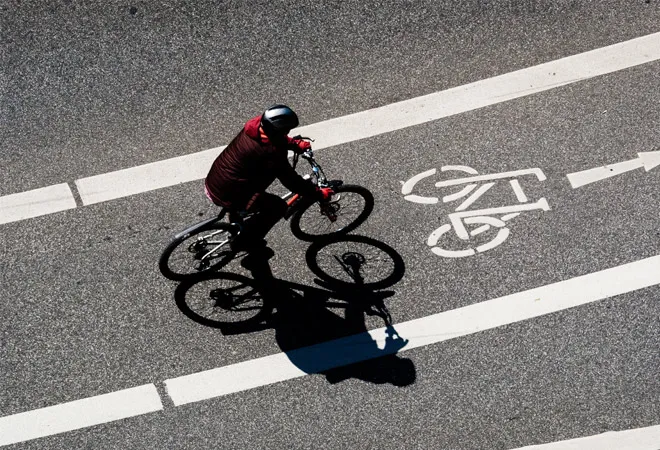-
CENTRES
Progammes & Centres
Location
Integrating the use of bicycles and establishing a sound cycling infrastructure will help India in its quest to achieve sustainable development

The United Nations (UN) and World Health Organisation (WHO) declared 3 June as World Bicycle Day, to recognise the contribution of bicycles towards eco-friendly and affordable transport mechanisms. The UN General Assembly, on 15 March 2022, adopted the resolution to include bicycling as an integral part of the public transport system to foster sustainable development. The WHO recognised that safe infrastructure for walking and cycling are essential to achieve health equity. Some of the prominent cities in the world are characterised by a vibrant, functional, and active cycling infrastructure. However, most of these cities, with the exception of Bogota (in Colombia), like Helsinki, Amsterdam, Copenhagen, Berlin, Taipei, and Tokyo are located in developed nations. It is rare for a city from a developing country to have sound cycling infrastructure, considering urban expansion and urbanisation are happening at a rapid scale in these nations, and attention to cycling as a viable mode of public transport is almost negligible.
Some of the prominent cities in the world are characterised by a vibrant, functional, and active cycling infrastructure.
In Indian cities, owing to its vast section of informal economy workers, the use of bicycles is prominent. These workers are involved in a wide range of professions such as newspaper delivery, domestic work, construction, delivery/courier services, amongst others. Unfortunately, urban planning and law in India have largely ignored integrating bicycling practices while having a significant bias towards motorised vehicles, which has made bicycling in Indian cities a safety issue as well. In certain cities like Kolkata, colonial-era laws, such as ‘Calcutta Police Laws 1866’ (amended in 1910), which were formulated to prevent and penalise disruptions to city traffic, are misused by police authorities to fine cycle riders. Despite these factors that favour motorised modes of transport from the planning and at times legal perspectives, walking and bicycling dominate the modal use of transport in Indian cities.
According to the recent National Family Health Survey (NFHS), around 50 percent of households in India own a bicycle, and even though only 13.8 percent of people in urban areas use cars for commuting, most of the infrastructural investments are directed towards car transport. Taking the case of Mumbai, a survey from 2017 indicates only 2 percent of journeys are undertaken by bicycles. In addition, several of the new road infrastructure projects, such as the Bandra-Worli Sealink and Eastern Freeway, do not have provisions for bicycle transit. Such developments are contrary to the ‘Non-Motorised Transport (NMT) First Policy’ advocated by the ‘Comprehensive Mobility Plan for Greater Mumbai’, which was prepared by the Municipal Corporate of Greater Mumbai (MCGM) in 2016. It laid out pathways to increase pedestrian and bicycle modes of transport. There also remain significant challenges for women cyclists on Indian roads in terms of safety. Women cyclists are susceptible to unwarranted gestures and hostile actions by male motorists on the road, and such situations have led to a gender gap in cycling in India while also forcing women to change their commute pattern to avoid deserted streets.
Urban planning and law in India have largely ignored integrating bicycling practices while having a significant bias towards motorised vehicles, which has made bicycling in Indian cities a safety issue as well.
According to a study by The Energy and Resources Institute (TERI), if bicycles replaced motorised vehicles for short distance trips, it can result in an annual benefit of INR 1.8 trillion (1.6 percent of India’s annual GDP in 2015-16) through energy savings (oil equivalent) and CO2 emission reduction. The report also states that 87 percent of the total CO2 emission in the transport sector were caused by motorised road transport and greenhouse gas emissions in Indian cities are largely caused by vehicular emission.
During the COVID lockdown period, the bicycle emerged as a preferred mode of transport for many, while it was also adopted by many for physical and recreational activities. The use of bicycles has also witnessed a notable increase among gig-workers (delivery personnel), given the high cost of using petrol-run vehicles and low pay. However, riding bicyclyes in the summer heat has taken a toll on their physical health as well. Popular food joints across Indian cities are now characterised with a large number of cycles waiting outside to be used by the delivery personnel once the next order comes in.
The aspiration to make Indian cities ‘world class’ must be tied to creating the best public infrastructure driven towards equitable and sustainable outcomes. From a climate perspective, Indian cities are facing major threats in the form of extreme heat, heatwaves, flooding and onset of diseases, which deems planning new cities and redesigning old cities to accommodate bicycling practices as a redressal measure. In recent times, the Government of India has taken some steps to mainstream cycling practices in Indian cities, which includes India Cycles4Change Challenge under the Smart City programme.
India’s urban planning can learn from such policies and create infrastructure that would encourage the culture of cycling.
At the state level, Bihar and West Bengal have initiated programmes for providing schoolgirls with bicycles, which have been hailed as successful in terms of reducing the gender gap in secondary school. The West Bengal government’s Saboojsathi programme (providing bicycles to school children enrolled in government-aided educational institutes) won the World Summit on the Information Society (WSIS) Award for 2019, under the e-governance category due to its social impact among school going children. Such instances show that facilitating mobility through bicycles can have multiplier impacts and achieve emancipatory goals, which are recognised at global levels. India’s urban planning can learn from such policies and create infrastructure that would encourage the culture of cycling. Examples from smaller towns, such as Ranchi and recent urban agglomerations such as Newtown, Kolkata, can provide relevant pathways that can be incorporated for bicycle-friendly Indian cities. Some basic steps such as - ensuring pothole free roads and bicycle lanes, reducing tax on bicycle purchase, and establishing bicycle parking stations at major transit hubs (bus, railway, metro station) can boost cycling practices in Indian cities. There has been a thrust in public transport in Indian cities through investments in metro railways in recent years, however, even in the capital city New Delhi, last mile connectivity remains an issue. Bicycle bays across the metro stations in urban India, through a multimodal integration plan, can play a key role towards addressing the issue.
At a global scale, India’s expansion of cycling practices will also advance the achievement of its COP26 (Conference of Parties 26) commitments, which includes reduction of ‘total projected carbon emissions by one billion tonnes by 2030.’ To that end, evaluation of carbon credits achieved by India due to bicycle usage will be the first step, which should also be utilised to incentivise regular bicycle users. A bicycle and NMT friendly urban India will also align with the Sustainable Development Goals of good health and well-being, affordable and clean energy, reduced inequalities, and sustainable cities and communities. While a national level policy geared towards bicycle-friendly cities is imperative, involving the local stakeholders (municipalities, urban local bodies, and traffic police departments) will determine the outcome for bicycles in Indian cities.
Snehashish Mitra is a Fellow with the Urban Studies at the Observer Research Foundation.
The views expressed above belong to the author(s). ORF research and analyses now available on Telegram! Click here to access our curated content — blogs, longforms and interviews.

Snehashish was an Urban Studies Fellow at ORF Mumbai. His research focus is on issues of urban housing, environmental justice, borderlands and citizenship politics. He has ...
Read More +